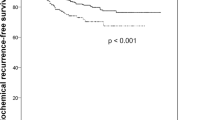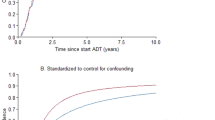Abstract
Background:
Obesity is consistently linked with prostate cancer (PCa) recurrence and mortality, though the mechanism is unknown. Impaired glucose regulation, which is common among obese individuals, has been hypothesized as a potential mechanism for PCa tumor growth. In this study, we explore the relationship between serum glucose at time of treatment and risk of PCa recurrence following initial therapy.
Methods:
The study group comprised 1734 men treated with radical prostatectomy (RP) or radiation therapy (RT) for localized PCa between 2001–2010. Serum glucose levels closest to date of diagnosis were determined. PCa recurrence was determined based on PSA progression (nadir PSA+2 for RT; PSA⩾0.2 for RP) or secondary therapy. Multivariate Cox regression was performed to determine whether glucose level was associated with biochemical recurrence after adjusting for age, race, body mass index, comorbidity, diagnosis of diabetes, Gleason Sum, PSA, treatment and treatment year.
Results:
Recurrence was identified in 16% of men over a mean follow-up period of 41 months (range 1–121 months). Those with elevated glucose (⩾100 mg/dl) had a 50% increased risk of recurrence (HR 1.5, 95% CI: 1.1–2.0) compared with those with a normal glucose level (<100 mg/dl). This effect was seen in both those undergoing RP (HR 1.9, 95% CI: 1.0–3.6) and those treated with RT (HR 1.4, 95% CI: 1.0–2.0).
Conclusions:
Glucose levels at the time of PCa diagnosis are an independent predictor of PCa recurrence for men undergoing treatment for localized disease.
This is a preview of subscription content, access via your institution
Access options
Subscribe to this journal
Receive 4 print issues and online access
$259.00 per year
only $64.75 per issue
Buy this article
- Purchase on Springer Link
- Instant access to full article PDF
Prices may be subject to local taxes which are calculated during checkout
Similar content being viewed by others
References
Ma J, Li H, Giovannucci E, Mucci L, Qiu W, Nguyen PL et al. Prediagnostic body-mass index, plasma C-peptide concentration, and prostate cancer-specific mortality in men with prostate cancer: a long-term survival analysis. Lancet Oncol 2008; 9: 1039–1047.
Calle EE, Rodriguez C, Walker-Thurmond K, Thun MJ . Overweight, obesity, and mortality from cancer in a prospectively studied cohort of US adults. N Engl J Med 2003; 348: 1625–1638.
Andersson SO, Wolk A, Bergstrom R, Adami HO, Engholm G, Englund A et al. Body size and prostate cancer: a 20-year follow-up study among 135006 Swedish construction workers. J Natl Cancer Inst 1997; 89: 385–389.
Wright ME, Chang SC, Schatzkin A, Albanes D, Kipnis V, Mouw T et al. Prospective study of adiposity and weight change in relation to prostate cancer incidence and mortality. Cancer 2007; 109: 675–684.
Efstathiou JA, Bae K, Shipley WU, Hanks GE, Pilepich MV, Sandler HM et al. Obesity and mortality in men with locally advanced prostate cancer: analysis of RTOG 85-31. Cancer 2007; 110: 2691–2699.
Gong Z, Agalliu I, Lin DW, Stanford JL, Kristal AR . Obesity is associated with increased risks of prostate cancer metastasis and death after initial cancer diagnosis in middle-aged men. Cancer 2007; 109: 1192–1202.
What are the risk factors for prostate cancer? American Cancer Society, Inc. http://www.cancer.org/Cancer/ProstateCancer/DetailedGuide/prostate-cancer-risk-factors., Accessed 2012.
Chornokur G, Dalton K, Borysova ME, Kumar NB . Disparities at presentation, diagnosis, treatment, and survival in African American men, affected by prostate cancer. Prostate 2011; 71: 985–997.
Osborne CK, Bolan G, Monaco ME, Lippman ME . Hormone responsive human breast cancer in long-term tissue culture: effect of insulin. Proc Natl Acad Sci USA 1976; 73: 4536–4540.
Pollak M . Insulin and insulin-like growth factor signalling in neoplasia. Nat Rev Cancer 2008; 8: 915–928.
Shinohara M, Thornalley PJ, Giardino I, Beisswenger P, Thorpe SR, Onorato J et al. Overexpression of glyoxalase-I in bovine endothelial cells inhibits intracellular advanced glycation endproduct formation and prevents hyperglycemia-induced increases in macromolecular endocytosis. J Clin Invest 1998; 101: 1142–1147.
DeNardo DG, Andreu P, Coussens LM . Interactions between lymphocytes and myeloid cells regulate pro- versus anti-tumor immunity. Cancer Metastasis Rev 2010; 29: 309–316.
Chan JM, Latini DM, Cowan J, Duchane J, Carroll PR . History of diabetes, clinical features of prostate cancer, and prostate cancer recurrence-data from CaPSURE (United States). Cancer Causes Control 2005; 16: 789–797.
Jayachandran J, Aronson WJ, Terris MK et al. Diabetes and outcomes after radical prostatectomy: are results affected by obesity and race? Results from the shared equal-access regional cancer hospital database. Cancer Epidemiol Biomarkers Prev 2010; 19: 9–17.
Smith MR, Bae K, Efstathiou JA, Hanks GE, Pilepich MV, Sandler HM et al. Diabetes and mortality in men with locally advanced prostate cancer: RTOG 92-02. J Clin Oncol 2008; 26: 4333–4339.
Kim HS, Presti JC, Aronson WJ, Terris MK, Kane CJ, Amling CL et al. Glycemic control and prostate cancer progression: results from the SEARCH database. Prostate 2010; 70: 1540–1546.
Barba M, Sperati F, Stranges S, Carlomagno C, Nasti G, Iaffaioli V et al. Fasting glucose and treatment outcome in breast and colorectal cancer patients treated with targeted agents: results from a historic cohort. Ann Oncol 2011; 23: 1838–1845.
Colangelo LA, Gapstur SM, Gann PH, Dyer AR, Liu K . Colorectal cancer mortality and factors related to the insulin resistance syndrome. Cancer Epidemiol Biomarkers Prev 2002; 11: 385–391.
Trevisan M, Liu J, Muti P, Misciagna G, Menotti A, Fucci F . Markers of insulin resistance and colorectal cancer mortality. Cancer Epidemiol Biomarkers Prev 2001; 10: 937–941.
Maynard C, Chapko MK . Data resources in the Department of Veterans Affairs. Diabetes Care 2004; 27 (Suppl 2): B22–B26.
Zeliadt SB, Sekaran NK, Hu EY, Slatore CC, Au DH, Backhus L et al. Comparison of demographic characteristics, surgical resection patterns, and survival outcomes for veterans and nonveterans with non-small cell lung cancer in the Pacific Northwest. J Thorac Oncol 2011; 6: 1726–1732.
Basaria S, Muller DC, Carducci MA, Egan J, Dobs AS . Hyperglycemia and insulin resistance in men with prostate carcinoma who receive androgen-deprivation therapy. Cancer 2006; 106: 581–588.
Klabunde CN, Legler JM, Warren JL, Baldwin LM, Schrag D . A refined comorbidity measurement algorithm for claims-based studies of breast, prostate, colorectal, and lung cancer patients. Ann Epidemiol 2007; 17: 584–590.
National Comprehensive Cancer Network. Prostate Cancer (Version 3.2012). Accessed Date May 2012. URL http://www.nccn.org/professionals/physician_gls/pdf/prostate.pdf.
Flood A, Mai V, Pfeiffer R, Kahle L, Remaley AT, Lanza E et al. Elevated serum concentrations of insulin and glucose increase risk of recurrent colorectal adenomas. Gastroenterology 2007; 133: 1423–1429.
Hong SK, Lee ST, Kim SS, Min KE, Byun SS, Cho SY et al. Significance of preoperative HbA1c level in patients with diabetes mellitus and clinically localized prostate cancer. Prostate 2009; 69: 820–826.
Hammarsten J, Hogstedt B . Hyperinsulinaemia: a prospective risk factor for lethal clinical prostate cancer. Eur J Cancer 2005; 41: 2887–2895.
Centers for Disease Control and Prevention. National diabetes fact sheet: national estimates and general information on diabetes and prediabetes in the United States. US Department of Health and Human Services, Center for Disease Control and Prevention: Atlanta, GA, 2011.
Zeliadt SB, Hoffman RM, Etzioni R, Ginger VA, Lin DW . What happens after an elevated PSA test: the experience of 13 591 veterans. J Gen Intern Med 2010; 25: 1205–1210.
Acknowledgements
This study was supported by NIH grants: P50CA097186 from the National Cancer Institute; with additional support from the Fred Hutchinson Cancer Research Center. This material is the result of work supported by resources from the VA Puget Sound Health Care System, Seattle, Washington.
Author information
Authors and Affiliations
Corresponding author
Ethics declarations
Competing interests
The authors declare no conflict of interest.
Rights and permissions
About this article
Cite this article
Wright, J., Plymate, S., Porter, M. et al. Hyperglycemia and prostate cancer recurrence in men treated for localized prostate cancer. Prostate Cancer Prostatic Dis 16, 204–208 (2013). https://doi.org/10.1038/pcan.2013.5
Received:
Revised:
Accepted:
Published:
Issue Date:
DOI: https://doi.org/10.1038/pcan.2013.5
Keywords
This article is cited by
-
Metabolic syndrome and its components predict the biochemical recurrence and adverse pathological features of patients following radical prostatectomy: a propensity score matching study
BMC Cancer (2023)
-
Oncologists’ responsibility, comfort, and knowledge managing hyperglycemia in patients with cancer undergoing chemotherapy: a cross sectional study
Supportive Care in Cancer (2023)
-
Metabolic syndrome and its pharmacologic treatment are associated with the time to castration-resistant prostate cancer
Prostate Cancer and Prostatic Diseases (2022)
-
The Adverse Effects of Androgen Deprivation Therapy in Prostate Cancer and the Benefits and Potential Anti-oncogenic Mechanisms of Progressive Resistance Training
Sports Medicine - Open (2020)
-
Pre-diagnostic carbohydrate intake and treatment failure after radical prostatectomy for early-stage prostate cancer
Cancer Causes & Control (2019)



